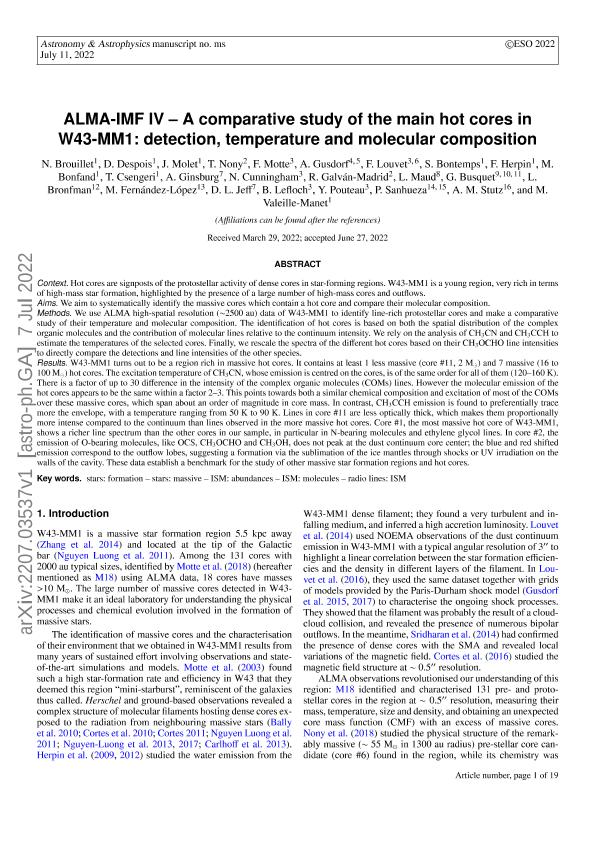Artículo
ALMA-IMF: IV. A comparative study of the main hot cores in W43-MM1: Detection, temperature, and molecular composition
Brouillet, N.; Despois, D.; Molet, J.; Nony, T.; Motte, F.; Gusdorf, A.; Louvet, F.; Bontemps, S.; Herpin, F.; Bonfand, M.; Csengeri, T.; Ginsburg, A.; Cunningham, N.; Galván Madrid, R.; Maud, L.; Busquet, G.; Bronfman, L.; Fernandez Lopez, Manuel ; Jeff, D. L.; Lefloch, B.; Pouteau, Y.; Sanhueza, P.; Stutz, A.M.; Valeille Manet, M.
; Jeff, D. L.; Lefloch, B.; Pouteau, Y.; Sanhueza, P.; Stutz, A.M.; Valeille Manet, M.
 ; Jeff, D. L.; Lefloch, B.; Pouteau, Y.; Sanhueza, P.; Stutz, A.M.; Valeille Manet, M.
; Jeff, D. L.; Lefloch, B.; Pouteau, Y.; Sanhueza, P.; Stutz, A.M.; Valeille Manet, M.
Fecha de publicación:
09/2022
Editorial:
EDP Sciences
Revista:
Astronomy and Astrophysics
ISSN:
0004-6361
Idioma:
Inglés
Tipo de recurso:
Artículo publicado
Clasificación temática:
Resumen
Context. Hot cores are signposts of the protostellar activity of dense cores in star-forming regions. W43-MM1 is a young region that is very rich in terms of high-mass star formation, which is highlighted by the presence of large numbers of high-mass cores and outflows. Aims. We aim to systematically identify the massive cores in W43-MM1 that contain a hot core and compare their molecular composition. Methods. We used Atacama Large Millimeter/sub-millimeter Array (ALMA) high-spatial resolution (~2500 au) data to identify line-rich protostellar cores and carried out a comparative study of their temperature and molecular composition. Here, the identification of hot cores is based on both the spatial distribution of the complex organic molecules and the contribution of molecular lines relative to the continuum intensity. We rely on the analysis of CH3CN and CH3CCH to estimate the temperatures of the selected cores. Finally, we rescale the spectra of the different hot cores based on their CH3OCHO line intensities to directly compare the detections and line intensities of the other species. Results. W43-MM1 turns out to be a region that is rich in massive hot cores. It contains at least one less massive (core #11, 2 M) and seven massive (16-100 M) hot cores. The excitation temperature of CH3CN, whose emission is centred on the cores, is of the same order for all of them (120-160 K). There is a factor of up to 30 difference in the intensity of the lines of complex organic molecules (COMs). However the molecular emission of the hot cores appears to be the same or within a factor of 2-3. This suggests that these massive cores, which span about an order of magnitude in core mass, have a similar chemical composition and show similar excitation of most of the COMs. In contrast, CH3CCH emission is found to preferentially trace the envelope, with a temperature ranging from 50 K to 90 K. Lines in core #11 are less optically thick, which makes them proportionally more intense compared to the continuum than lines observed in the more massive hot cores. Core #1, the most massive hot core of W43-MM1, shows a richer line spectrum than the other cores in our sample, in particular in N-bearing molecules and ethylene glycol lines. In core #2, the emission of O-bearing molecules, such as OCS, CH3OCHO, and CH3OH, does not peak at the dust continuum core centre; the blueshifted and redshifted emission corresponds to the outflow lobes, suggesting formation via sublimation of the ice mantles through shocks or UV irradiation on the walls of the cavity. These data establish a benchmark for the study of other massive star-formation regions and hot cores.
Archivos asociados
Licencia
Identificadores
Colecciones
Articulos(IAR)
Articulos de INST.ARG.DE RADIOASTRONOMIA (I)
Articulos de INST.ARG.DE RADIOASTRONOMIA (I)
Citación
Brouillet, N.; Despois, D.; Molet, J.; Nony, T.; Motte, F.; et al.; ALMA-IMF: IV. A comparative study of the main hot cores in W43-MM1: Detection, temperature, and molecular composition; EDP Sciences; Astronomy and Astrophysics; 665; 9-2022; 1-19
Compartir
Altmétricas



